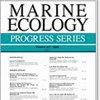Diet and size at birth affect larval rockfish condition and survival
IF 2.1
3区 环境科学与生态学
Q2 ECOLOGY
引用次数: 0
Abstract
ABSTRACT: Feeding success and maternal effects on larval size have long been hypothesized to be important contributors to interannual recruitment variability in marine fishes. This study examined the feeding ecology and influences of diet and size at birth on length and growth of larval rockfishes (Sebastes spp.). Prey carbon biomass and selection were calculated from gut contents, size at birth was estimated using otolith core size, and recent growth was derived from outer otolith increment widths. Biomass contributions of preferred prey and otolith data were integrated into Bayesian hierarchical models predicting length and growth. Larvae primarily fed on and selected for copepod nauplii and calanoid copepodites, modulating feeding with ontogeny and in response to prey availability. Based on carbon weight, the relative contribution of calanoid copepodites to the diet was more strongly and positively correlated with length and growth than that of nauplii. Younger larvae experienced faster growth in association with calanoid copepodite consumption than older larvae. Positive effects of core radius suggest that initial larval size, believed to be mediated by maternal provisioning, increases the likelihood of survival, larger size, and faster growth. These findings ultimately provide evidence that selective feeding and size at birth mediate rockfish survival in early life stages.饮食和出生时的大小影响岩鱼幼体的状况和存活率
摘要:长期以来,人们一直认为摄食成功率和母体对幼体大小的影响是造成海洋鱼类年际招募变化的重要因素。本研究考察了岩鱼(Sebastes spp.)幼体的摄食生态学以及出生时饮食和体型对其体长和生长的影响。根据肠道内容物计算了猎物碳生物量和选择,利用耳石核心尺寸估计了出生时的大小,并根据外耳石增量宽度推算了最近的生长情况。首选猎物的生物量贡献和耳石数据被整合到贝叶斯分层模型中,以预测长度和生长。幼体主要摄食并选择桡足类稚虫和桡足类稚虫,摄食量随个体发育和猎物可得性而变化。根据碳重计算,桡足类桡足虫在食物中的相对比例与体长和生长的正相关性比桡足类桡足虫更强。与老龄幼虫相比,低龄幼虫的生长速度与桡足类桡足虫的摄食量有关。核心半径的正效应表明,最初的幼体大小(据信是由母体供给介导的)增加了存活的可能性、更大的体型和更快的生长。这些发现最终提供了证据,证明出生时的选择性摄食和体型介导了岩鱼早期生命阶段的生存。
本文章由计算机程序翻译,如有差异,请以英文原文为准。
求助全文
约1分钟内获得全文
求助全文
来源期刊

Marine Ecology Progress Series
环境科学-海洋学
CiteScore
5.30
自引率
8.00%
发文量
238
审稿时长
3 months
期刊介绍:
The leading journal in its field, MEPS covers all aspects of marine ecology, fundamental and applied. Topics covered include microbiology, botany, zoology, ecosystem research, biological oceanography, ecological aspects of fisheries and aquaculture, pollution, environmental protection, conservation, and resource management.
 求助内容:
求助内容: 应助结果提醒方式:
应助结果提醒方式:


